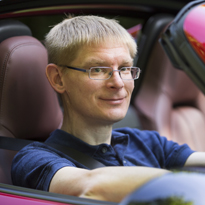Aston Martin could use oscillating body structures on future performance EVs to simulate the experience of driving a V12-engined sports car, company boss Adrian Hallmark has hinted.
The British firm is currently developing its first production electric car, which is due to arrive by 2030.
It has a deal with EV start-up Lucid to use its electric motors, inverters and other technology, but Hallmark insisted that the cars would be true Astons.
Adrian Hallmark's Aston Martin plan: first EV by 2030, but first comes a hybrid blitz
Asked how Aston could can produce a true electric performance car that could match the emotion of its existing models in the future, Hallmark ruled out the use of fake gearshifts or engine noises that feature in EVs such as the Hyundai Ioniq 5 N.
He said that he recently drove the Mercedes-AMG EQS “and that gave me hope” because "without fake gear changes or engine noise, it resonates. I don’t mean emotionally but physically. It physically resonates.
“If you mapped the telemetry of the V12 engine from the Valkyrie, or even the engine from the race version, measured the frequencies and built those into the body structure of the vehicle, linked them to the throttle position and suppressed the electrical frequency noises, you would feel exactly like you were in a Valkyrie or another 12-cylinder car.
“So I believe without fake noises but by actually oscillating body structures and other structures with the frequencies that you get from a combustion powertrain, you can create an emotional connection.”
Hallmark also hinted that weight reduction will be a key objective for future performance EVs, citing solid-state batteries as crucial in that aim – although he was clear that such technology wouldn't feature on the first wave of Aston EVs.
“The biggest number issue [in making a performance EV] is weight, because we all know that a car that is lighter feels better, even at the same level of performance," he said.
"The problem with battery electric vehicles is that’s very difficult to get that dynamic feel that you get from a genuinely lightweight performance car. Mass is the enemy, and with EVs, mass is part of the DNA.”
Hallmark said that the battery was the single biggest challenge and “you can't save enough on everything else to compensate for the burden” it brings.










Join the debate
Add your comment
Why on earth would you vibrate the whole car, rather than just the seats/steering wheel?
He might be onto something there. EV's are inherently soulless. I had no time for EVs, for all sorts of reasons... and to some degree still don't... but I recently (and begrudgedly) test drove an Ioniq 5N and was surprised at what a great time I had in that with its well guaged fake noise and gearshifts. If it physically buzzed as well, it would have even more character. Couldn't help myself afterwards though, thinking "if only it had a 3 litre straight six, weighed 500kg less and cost £50k..."
How sad is that!